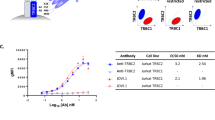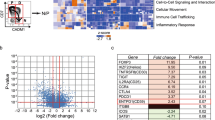Abstract
CD95 (Fas/APO-1) is a cell surface receptor able to trigger apoptosis in a variety of cell types. The expression and function of the CD95 antigen on leukemic blasts from 42 patients with B lineage and 53 patients with T lineage acute lymphoblastic leukemia (ALL) were investigated using immunofluorescence staining and apoptosis assays. The CD95 surface antigen was expressed in most ALL cases, with the T lineage ALL usually showing a higher intensity of surface CD95 expression as compared with the B lineage ALL cells (relative fluorescence intensity, RFI: 4.8 ± 0.47 vs 2.2 ± 0.23, respectively, P < 0.01). Functional studies disclosed that upon oligomerization by anti-CD95 monoclonal antibodies the CD95 protein was either not able to initiate apoptosis of leukemic cells (75% of cases) or induced low rates of apoptosis (20% of cases). Only in 5% of cases did the apoptosis rate exceed the 20% level of the CD95-specific apoptosis. Most of the CD95-sensitive cases were found among T lineage ALLs (38% of T lineage vs 10% of B lineage ALLs). Overall, the extent of CD95-induced apoptosis did not correlate with the expression level of CD95. Similarly, no significant correlation between expression level and functionality of CD95 in human leukemia cell lines of B and T cell origin could be observed. Bcl-2 protein has been associated with prolonged cell survival and has been shown to block partially CD95-mediated apoptosis, but for ALL cells no correlation between bcl-2 expression and spontaneous or CD95-mediated apoptosis could be found. The results obtained in this study indicate that, despite constitutive expression of CD95, the ALL cells are mainly resistant to CD95-triggering. More detailed investigations of the molecular mechanisms involved in the intracellular apoptotic signal transduction, such as interactions of the bcl-2 and the other members of the bcl-2 family, and functionality of the interleukin-1β converting enzyme (ICE) like-proteases, may give new insights into key events responsible for the resistance or sensitivity to the induction of apoptosis in acute leukemia.
This is a preview of subscription content, access via your institution
Access options
Subscribe to this journal
Receive 12 print issues and online access
$259.00 per year
only $21.58 per issue
Buy this article
- Purchase on Springer Link
- Instant access to full article PDF
Prices may be subject to local taxes which are calculated during checkout
Similar content being viewed by others
Author information
Authors and Affiliations
Rights and permissions
About this article
Cite this article
Karawajew, L., Wuchter, C., Ruppert, V. et al. Differential CD95 expression and function in T and B lineage acute lymphoblastic leukemia cells. Leukemia 11, 1245–1252 (1997). https://doi.org/10.1038/sj.leu.2400746
Received:
Accepted:
Issue Date:
DOI: https://doi.org/10.1038/sj.leu.2400746
Keywords
This article is cited by
-
Molecular Pharmacodynamics in Childhood Leukemia
International Journal of Hematology (2003)
-
In vitro susceptibility to TRAIL-induced apoptosis of acute leukemia cells in the context of TRAIL receptor gene expression and constitutive NF-κB activity
Leukemia (2001)
-
Glutamine deprivation-mediated cell shrinkage induces ligand-independent CD95 receptor signaling and apoptosis
Cell Death & Differentiation (2001)
-
Relapse in childhood acute lymphoblastic leukemia is associated with a decrease of the Bax/Bcl-2 ratio and loss of spontaneous caspase-3 processing in vivo
Leukemia (2000)



